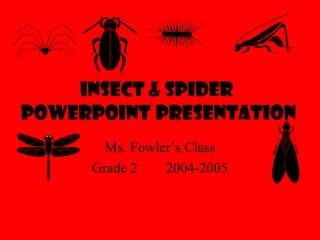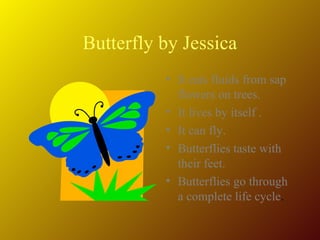Insect powerpoint presentation
- 1. Insect & Spider Powerpoint Presentation Ms. Fowler’s Class Grade 2 2004-2005
- 2. Wolf spider by:Isabella • It eats lizards and frogs. • It lives by itself. • It does not fly. • It live in Australia. • They have hairy bodies. • They do not go through a complete life cycle..
- 3. Tarantula by Lance Billie • It lives in the desert. • It does not fly. • It does not go through a complete life cycle. • It can be a pet. • It does not live in groups. • It eats small birds and insects.
- 4. FLY BY ANTHONY • Some flies eat food and some don’t. • Flies live in groups. • Flies fly. • A fly lives all around the world. • A fly is fast. • A fly is small. • A fly has a complete life cycle.
- 5. Butterfly by Jessica • It eats fluids from sap flowers on trees. • It lives by itself . • It can fly. • Butterflies taste with their feet. • Butterflies go through a complete life cycle.
- 6. Black Widow By: Ashlee • It eats cockroaches. • It lives by itself. • It doesn’t fly. • It lives under rocks. • It is the most poisonous spider in America. • It lives in the desert. • It does not have a complete life cycle.
- 7. Daddy long legs by:Destanie Moore • It eats other daddy long legs. • It lives all by itself. • It lives in a tree trunk. • It does not have a complete life cycle.
- 8. Mealworm by Michael • It eats leaves and grass. • It lives in groups. • The beetle flies. • It lives on the ground. • It turns into a pupa. • It has a complete life cycle.
- 9. Butterfly by:Shalleen • It eats tree sap and nectar. • It lives by it self. • It flies. • It lives in trees or gardens. • Some butterflies are poisonous. • The monarch is the most poisonous. • A butterfly has a complete life cycle.
- 10. Black Widow by Sabastian • It eats insects. • It lives by itself. • It doesn’t fly. • It lives in the desert. • It is called the hourglass spider. • It goes through an incomplete life cycle.
- 11. Ladybug by Brianna • It eats aphids. • It lives by itself. • It flies. • It lives in gardens and trees. • It has spots on its back. • The ladybug goes through a complete life cycle.
- 12. Butterfly by:Meghan  It eats tree sap.  It lives by itself.  It flies.  It lives in a garden.  The most common butterfly is the cabbage white.  It goes through a complete life cycle.
- 13. Daddy Long Legs By: Nick • Daddy long legs eat other daddy long legs. • It eats flies too. • It lives by itself. • It does not fly. • It lives in tree trunks and walls. • It doesn’t bite people.
- 14. Scorpion by Jesse DeLaPaz • It eats insects. • It lives by itself. • It lives in the desert. • It has 12 eyes. • It does not go through a complete life cycle.
- 15. Taylor’s Wolf Spider • It eats crickets and ants. • It lives by itself. • It does not fly. • It lives all over Australian grasslands. • It hunts rather than builds a sticky web to catch prey. • Spiders do not go through the complete lifecycle.
- 16. Ladybug by Connor • It eats aphids. • It lives in groups. • It does fly. • It lives in gardens. • They chew side to side. • They have a complete life cycle.
- 17. Swallowtail by Jazmin • It eats wild cherry leaves. • It lives in groups. • It does fly. • They do not grow once they have reached their adult stage. • It has a complete live cycle.
- 18. Wolf Spider by Enrique Lopez • It eats crickets. • It doesn’t fly. • It lives in Australia. • It has a painful bite.
- 19. Tarantula by Sabrina • It eats insects. • It lives by is self. • It does not fly. • It lives in the desert. • It is the largest spider in the world.
- 20. Trapdoor Spider by Andres • It eats insects. • It lives in groups. • It doesn’t fly. • It lives in the desert. • The spider has eight eyes. • It doesn’t have a complete life cycle.
- 21. The Widow By : Zack • It eats insects. • It lives by itself. • It does not fly. • It lives in the desert. • Only the female has the red hour glass. • It does not have a complete life cycle.
- 22. Butterfly by Iridian • It eats fluids from sap flowers on a tree. • It lives by itself. • It flies. • It lives on low plants. • They communicate with each other by colors, chemicals, sound, and physical actions. • It goes though a complete life cycle.






















